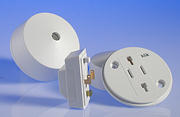I'm talking about the circular tubes in a round ceiling unit. Cutting the power means darkness in the room as both lights are on the same switch so I've simply removed the dead lamp and put a new one in. There seems to be virtually no chance of coming into contact with anything live, but someone has pointed out that I should always cut the power and that I wouldn't be allowed to do this at work.
What's the risk? Is there one? Is my friend right? Would I be breaching regs if I did this at work?
What's the risk? Is there one? Is my friend right? Would I be breaching regs if I did this at work?


